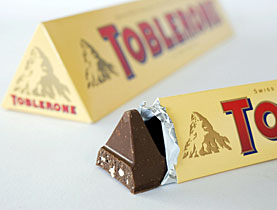
A triangle turns 100

Switzerland's best known chocolate began as an experiment over a kitchen stove; a century later it is a favourite in 110 countries round the world.
The Swiss pride themselves on their innovative spirit, and Toblerone is no exception. No one had mixed chocolate and nougat before Theodor Tobler and his cousin Emil Baumann tried out the idea over that stove in 1908.
But equally groundbreaking were the marketing ideas that tumbled out of Tobler and pushed his brand in general and the new bar in particular to the top.
The triangular shape was in itself a stroke of genius – and practical too. The pieces could be broken off and the remainder pushed back into the tube.
The widespread legend is that Tobler was inspired by the shape of the Matterhorn, but according to his grandson Andreas, Theodor in fact got the idea from the dancers had seen at the Folies Bergeres in Paris forming a human triangle as part of their act.
The name is a combination of Tobler’s surname and “torrone”, the Italian word for nougat. Typically for Tobler, it simultaneously promoted the brand and the individual product. He was quick to patent both name and recipe.
Marketing man
Tobler had early understood the importance of getting his name in the public eye, at a time when many manufacturers expected to sell their products by word of mouth.
He came under fire from his shareholders for the huge sums spent on publicity, and also from the Swiss Heritage Society for plastering the city with sheet metal advertisements.
But he was unrepentant.
“You can become well-known by letting time do its work. But then you risk being overtaken by others before you reach your goal,” he once commented to justify his strategy.
Early advertising focused on the Tobler name. It was only in the 1920s that the company started to push Toblerone itself, initially as a product for women and children.
Tobler was well aware that the domestic market was very small, and that he needed worldwide sales. In a marketing event in 1921 Toblerone samples were handed out to passers-by in London.
“There will soon be no one in London who has not heard of Toblerone, and this is a city with a larger population than the whole of Switzerland,” commented the firm’s customer magazine, Jurnalo Tobler.
Triumph and disaster …
Tobler’s entrepreneurial spirit and his willingness to take risks was both his strength and his weakness. He had taken over his father’s chocolate business in Bern in 1900 when he was 24. He was proud of his humble roots and his business acumen, which set him apart from Bern’s conservative elite.
For years the company did very well. It could not only pay good dividends to its shareholders, it also had a healthcare system for its workers, and provided old age and disability pensions at a time when this was by no means standard.
From the beginning Tobler embarked on a course of expansion, becoming the third -biggest Swiss chocolate manufacturer by the early 1920s. But as the decade went on, economic depression began to bite.
The company found itself in severe financial difficulty, and in 1931 the creditor banks appointed their own man to take over. Tobler was squeezed out. He died in 1941.
After a series of takeovers, Toblerone has been part of Kraft Foods since 2000.
…and triumph again
But whatever the fate of the parent company, the bar has continued to go from strength to strength. Tobler’s dream of worldwide sales has been fulfilled: 96 per cent of Toblerone production goes abroad. The 400-gram Toblerone Gold is the most popular confectionary item in duty free shops.
Nor has it lagged behind on inventiveness. It has broadened its range with new flavours and sizes. In 1982 Toblerone entered the Guinness Book of Records with a seven-kilogram bar.
An unusual publicity event is to mark this centenary year. In late spring, Switzerland’s four largest cities are to compete against each other for the honour of hosting the “great Toblerone Anniversary Celebration” in September.
The challenge is to build the highest tower of Toblerone boxes the fastest. Anyone can help – but the boxes will be empty!
swissinfo, Julia Slater
The Toblerone bar was first produced in 1908.
For many years the factory was in Bern, but was moved to a site a few kilometres outside the city in 1991.
The old factory was converted into the main Bern University library, and is now called Unitobler.
The centenary is being celebrated with a touring exhibition, to be seen in eight Swiss cities and also in Cologne and Vienna.
A well-illustrated 200-page book on the history of the Toblerone has been published in German for the centenary, under the title “100 Jahre Toblerone”. The authors include Tobler’s grandson, historian Andreas Tobler.

In compliance with the JTI standards
More: SWI swissinfo.ch certified by the Journalism Trust Initiative
















![The four-metre-long painting "Sonntag der Bergbauern" [Sunday of the Mountain Farmers, 1923-24/26] had to be removed by a crane from the German Chancellery in Berlin for the exhibition in Bern.](https://www.swissinfo.ch/content/wp-content/uploads/sites/13/2025/12/01_Pressebild_KirchnerxKirchner.jpg?ver=a45b19f3)










You can find an overview of ongoing debates with our journalists here . Please join us!
If you want to start a conversation about a topic raised in this article or want to report factual errors, email us at english@swissinfo.ch.